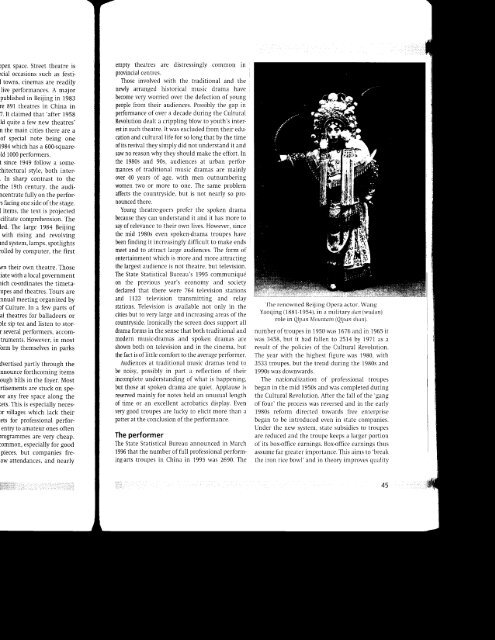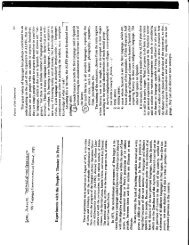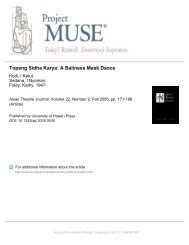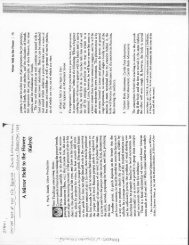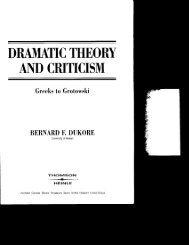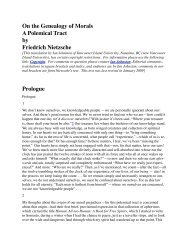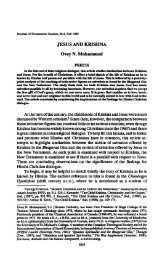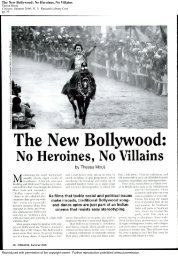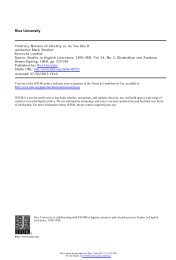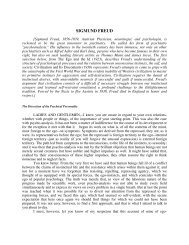Contemporary China - Yavanika
Contemporary China - Yavanika
Contemporary China - Yavanika
You also want an ePaper? Increase the reach of your titles
YUMPU automatically turns print PDFs into web optimized ePapers that Google loves.
)pen space. Street theatre is<br />
lcial occasions such as festi-<br />
I towns, cinemas are readily<br />
live perforrnances. A major<br />
published in Beijing in 1983<br />
re 891 theatres in <strong>China</strong> in<br />
7. It claimed that 'after 1958<br />
ld quite a few new theatres'<br />
n the main cities there are a<br />
of special note being one<br />
1984 which has a 600-squareld<br />
1000 performers.<br />
t since 1949 follow a some-<br />
:hitectural style, both inter-<br />
. ln sharp contrast to the<br />
the 19th centuly, the audincentrate<br />
fully on the perfors<br />
facing one side ofthe stage.<br />
I items, the text is projected<br />
cilitate comprehension. The<br />
led. The Iarge 1984 Beijing<br />
with rising and revolving<br />
rnd system, lamps, spotlights<br />
:olled by computer, the first<br />
,,rn their own theatre. Those<br />
.iate with a local government<br />
rich co-ordinates the timetaupes<br />
and theatres. Tours are<br />
nnual meeting organized by<br />
rf Culture. In a few parts of<br />
al theatres for balladeers or<br />
rle sip tea and listen to storr<br />
several performers, accomtruments.<br />
However, in most<br />
brm by themselves in parks<br />
dvertised partly thlough the<br />
nnounce forthcoming items<br />
ough bills in the foyer. Most<br />
rtisements are stuck on speor<br />
any free space along the<br />
rets. This is especially necesrr<br />
villages which lack their<br />
ets for professional perforentry<br />
to amateur ones often<br />
)rogramnes are very cheap.<br />
rommon, especially for good<br />
pieces, but companies freow<br />
attendances, and nearly<br />
empty theatres are distre ssingly comnon<br />
nrovincirl<br />
centres<br />
Those involved with the traditional and the<br />
newly arranged historical music drana have<br />
become very worried over the defection of young<br />
people from their audiences. Possibly the gap in<br />
performance ofover a decade during the Cultural<br />
Revolution dealt a crippling blow to youth's interest<br />
in such theatre. It was excluded from their education<br />
and cultural life fbr so long that by the time<br />
ofits revival they simply did not understand it and<br />
saw no reason why they should nake the effort. hi<br />
the 1980s and 90s, audiences at urban performances<br />
of traditional music dlamas are mainly<br />
over 40 years of age, with men outnumbering<br />
women fwo or more to one. The same problem<br />
affects the countryside, but is not nearly so pronounced<br />
there.<br />
Young theatre-gocrs prcfer the spoken drana<br />
because they can understand it and it has more to<br />
say ofrelevance to their own lives. However', since<br />
the mid 1980s even spoken-drama troupes have<br />
been finding it increasingly difhcult to make ends<br />
meet and to attract large audiences. The form of<br />
entertainment which is more and nore attracting<br />
the largest audience is not theatre, but television.<br />
The State Statistical Bureau's 1995 communiqr.ri<br />
on the previous year's econony and society<br />
declared that there were 764 television stations<br />
and 1123 television transmitting and relay<br />
stations. Television is available not only in the<br />
cities but to very largc and incrcasing areas ofthe<br />
countryside. Ironically the screen does support all<br />
drama forms in the sense that both traditional and<br />
modern music-dramas and spoken dramas are<br />
shown both on television and in the cinema, but<br />
the fact is oflittle comfort to the average perforner.<br />
Audiences at traditional nusic dranas tend to<br />
be noisy, possibly in part a reflection of their<br />
incomplete understanding of what is happening,<br />
but those at spoken drama are quiet. Applause is<br />
reserved mainly fbr notes held an nnusual length<br />
of tine ol an excellent acrobatics display. Even<br />
very good troupes are lucky to elicit more than a<br />
prl ter at t he concl u si ou of t he per'folunnt e.<br />
The performer<br />
The State Statistical Bureau announced in March<br />
1996 that the number offull professional performing-arts<br />
tloupes in <strong>China</strong> in 1995 was 2690. The<br />
in<br />
'lhe rcnownecl llcijing Opera:rctor, Wang<br />
Yaoqing 11881-1954), in a military dan (wudon)<br />
lole in Qipan Mornrdin (qipdn shdll).<br />
nunber oftroupes in 1950 was 1676 and in 1965 it<br />
was 3458, but it had fallen to 2514 by 1971 as a<br />
r-esult of the policies of the Cultural Revolntion.<br />
Thc ycar with the highest figure was 1980, with<br />
3533 troupes, bnt the trend during the 1980s and<br />
1990s was downwards,<br />
The nationalization of professional troupes<br />
began in the nid 1950s and was corlpleted duling<br />
the Cultural Revolution. After the fall ofthe 'gang<br />
of four'' the process was reversed and in the early<br />
1980s reform dirccted towards fiee cnterprise<br />
begarr to be intloduced evrn in rtate (onlpilllies.<br />
Under the new system, state subsidies to troupes<br />
are reduced and the troupe keeps a larger portion<br />
of its box-office earnings. tsox-offic earnings thus<br />
assume far greater importance. This aims to 'break<br />
thc iron rice bowl' ancl in theory inproves cp.rality


